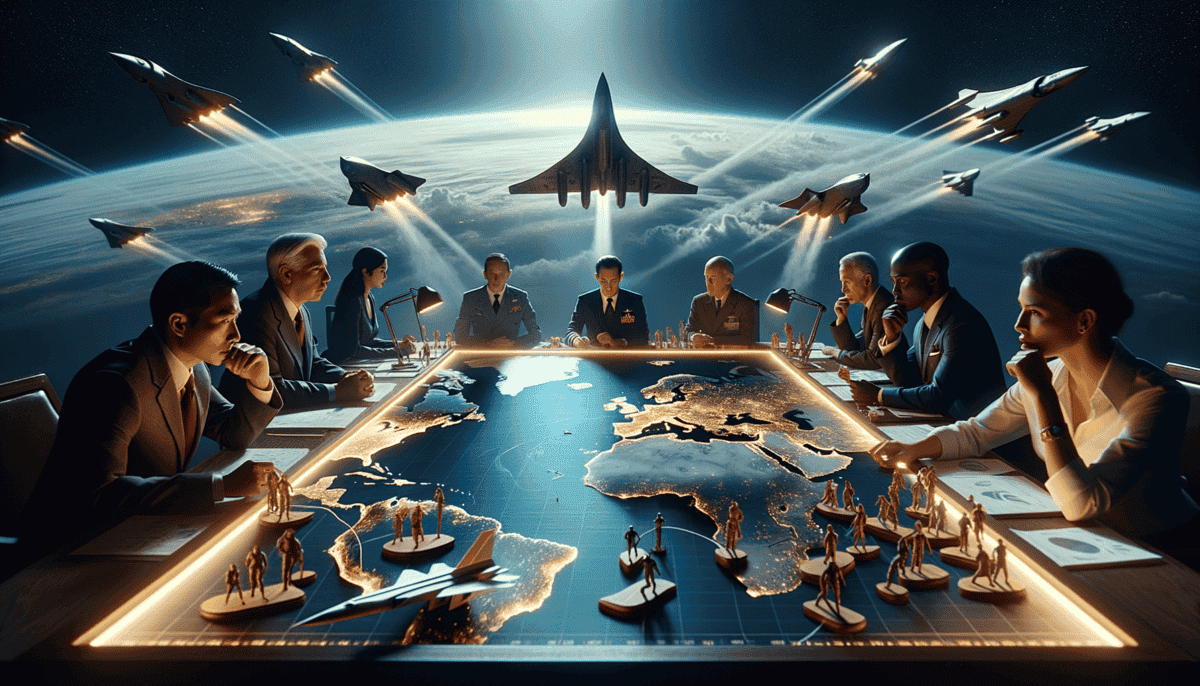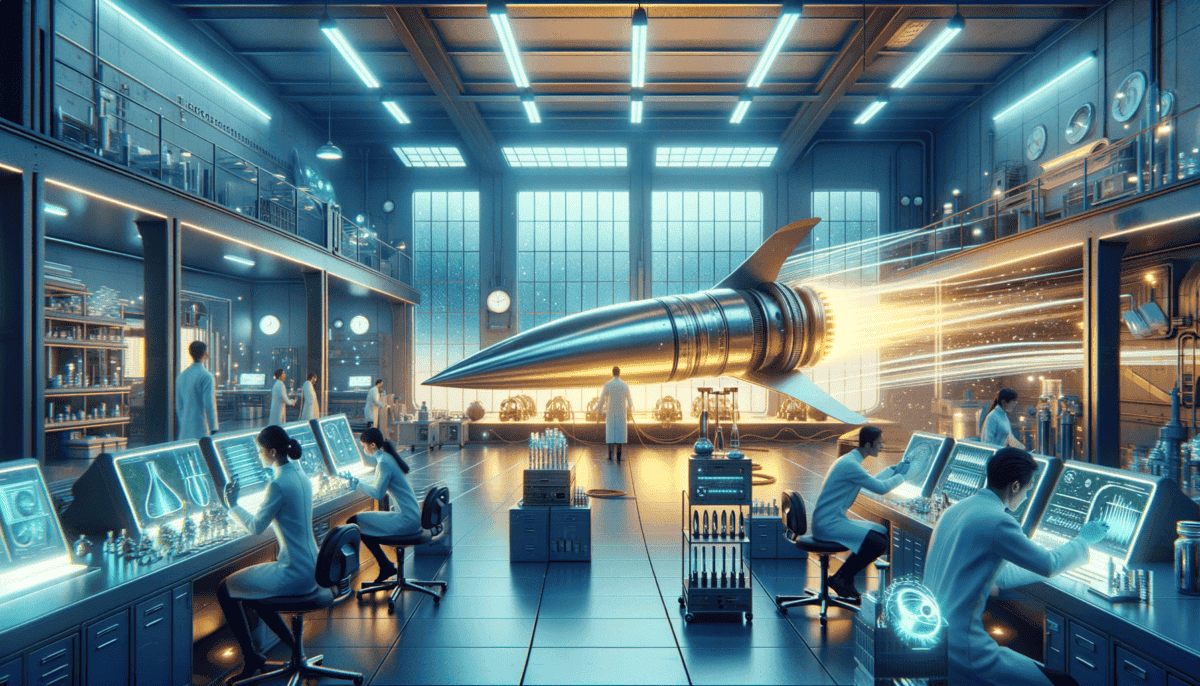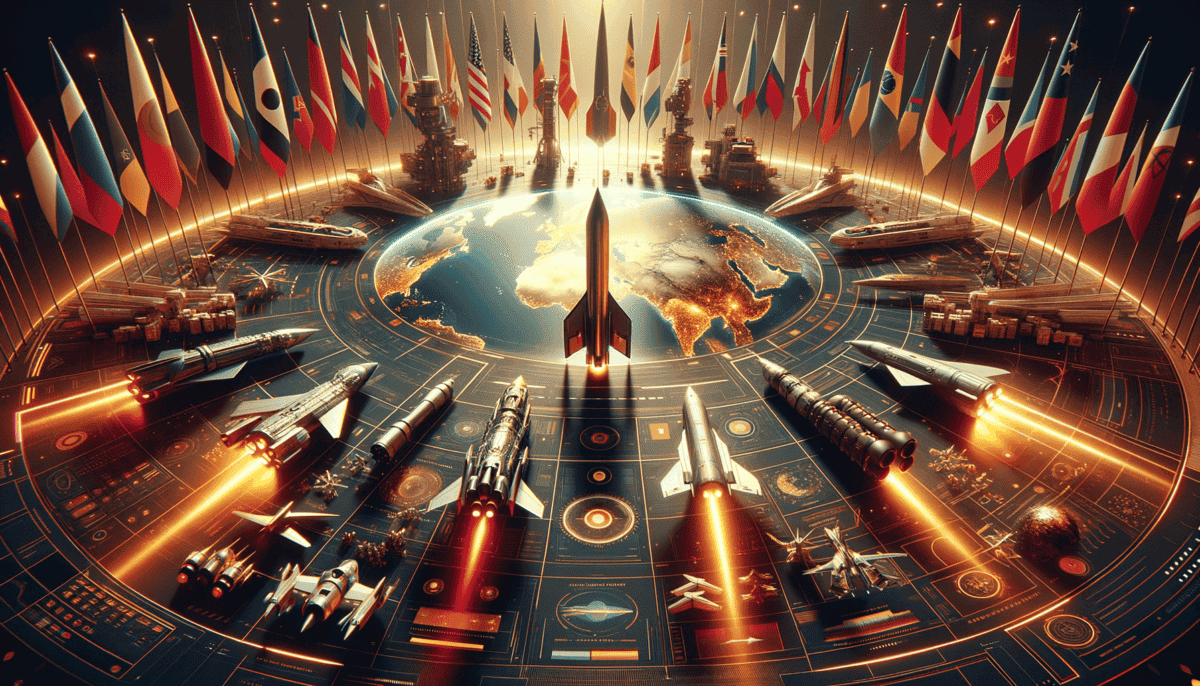The Dream Takes Flight
Tommy stared at the paper airplane in his hand. His dad, Dr. James Miller, smiled as he helped fold the last wing. ️
"Want to know something cool?" Dr. Miller asked. "Some planes can fly faster than you can blink!"
Tommy's eyes grew wide. "Really? How fast?"
"Let me tell you about the fastest planes ever made," Dr. Miller said, settling into his favorite chair. "It all started a long time ago, when brave people had big dreams about flying super fast."
Dr. Miller pulled out an old photo album. "See this picture? This is Chuck Yeager, one of the bravest pilots ever. He was the first person to fly faster than the speed of sound."
"What does sound look like?" Tommy asked, scrunching his nose.
"Well, imagine throwing a rock in a pond," Dr. Miller explained. "The ripples that spread out are like sound waves moving through the air. When something goes faster than sound, it makes a big BOOM!"
Tommy jumped up excitedly. "Like a superhero?"
"Kind of! These super-fast planes are called hypersonic aircraft. They're like space rockets and airplanes combined."
The Power of Dreams
Dr. Miller showed Tommy more pictures of amazing aircraft. There were strange-looking planes with pointed noses and tiny wings. Some looked like giant bullets with engines.
"Back in the 1950s, scientists like me had a dream," Dr. Miller continued. "We wanted to build planes that could fly faster than anyone thought possible. Many people said it couldn't be done."
"But they did it anyway?" Tommy asked.
"That's right! They worked really hard and never gave up. Just like when you learned to ride your bike – remember how many times you fell?"
Tommy nodded, remembering his own determination.
Breaking Barriers
"The hardest part was dealing with heat," Dr. Miller explained. "When planes fly really fast, they get super hot – hotter than your mom's oven!"
"Like a dragon breathing fire?" Tommy asked excitedly.
"Exactly! So scientists had to invent new materials that wouldn't melt. It was like making a suit of armor for the plane."
Dr. Miller picked up Tommy's paper airplane. "Your plane is made of paper, but hypersonic planes are made of special metals that can handle extreme heat."
Tommy looked at his paper plane with new appreciation. "Can I make a hypersonic plane when I grow up?"
"Of course you can! That's what's so exciting about science – there's always something new to discover and create. The dream of flying faster continues with kids like you."
As the evening sun cast long shadows through the window, Tommy launched his paper airplane across the room. He watched it soar, imagining it breaking the sound barrier like Chuck Yeager's plane.
"Dad?" Tommy asked, retrieving his plane. "Will you help me build a faster one tomorrow?"
Dr. Miller hugged his son. "Always, Tommy. That's how all great discoveries start – with curiosity and a dream."
The paper airplane sat on Tommy's desk that night, its sharp folds catching moonlight. In his dreams, Tommy saw himself piloting fantastic aircraft, pushing the boundaries of speed just like the pioneers his father had told him about.
Cold War Velocity
Tommy rushed into his dad’s study, holding a newspaper. “Dad, look! It says here that Russia has super-fast rockets!”
Dr. Miller adjusted his glasses. “Ah yes, that reminds me of a fascinating story from the Cold War – when America and Russia were racing to build the fastest vehicles ever.”
“Was it like our race to school this morning?” Tommy asked, remembering their playful competition.
Dr. Miller chuckled. “Kind of, but much bigger! Both countries wanted to protect themselves by having the fastest rockets and planes.”
The Great Speed Race
“It all started in the 1950s,” Dr. Miller explained, pulling out an old magazine. “Scientists on both sides worked day and night in secret labs.”
“Like superhero secret hideouts?” Tommy’s eyes sparkled.
“Sort of! In America, we had a special place called Area 51 where test pilots flew experimental aircraft. In Russia, they had their own secret places too.”
Breaking Records
“The fastest plane from that time was called the X-15,” Dr. Miller said, showing Tommy a picture. “It could fly six times faster than the speed of sound!”
“Whoosh!” Tommy zoomed his paper airplane through the air.
“Each country kept trying to build faster and better vehicles. When one side made something new, the other side would try to make something even better.”
Tommy frowned. “Did they fight?”
“No, they just competed – like a chess game. But this competition led to amazing discoveries that help us today!”
The Scientists’ Stories
Dr. Miller pulled out a photo of a group of scientists. “These are some of the brilliant minds who worked on hypersonic technology. See this woman? Her name was Dr. Sarah Chen. She figured out how to make materials that wouldn’t melt at super-high speeds.”
“Like a force field?” Tommy asked excitedly.
“Close! She created special metals and ceramics that could handle extreme heat. It was like inventing a new kind of cookie sheet that never burns the cookies!”
“The really interesting part,” Dr. Miller continued, “was how the scientists shared their ideas. Even though their countries were competing, they would sometimes meet at conferences to talk about their work.”
Tommy looked puzzled. “But I thought it was a secret?”
“Some things were secret, but sharing knowledge helped everyone make better and safer vehicles. It’s like when you share your toys with friends – everyone has more fun!”
The Speed Legacy
“What happened to all those fast planes?” Tommy asked, picking up his paper airplane.
“Many of them are in museums now, but the ideas and discoveries live on. Today, countries are still working on making even faster vehicles.”
Tommy stood up straight. “I want to help build the fastest plane ever!”
Dr. Miller smiled proudly. “You know what? The same spirit that drove those Cold War scientists lives in curious kids like you. Maybe you’ll be the one to break the next speed record!”
As evening approached, Tommy carefully placed his paper airplane collection on his desk. Each one represented a different era of speed, from Chuck Yeager’s time to the Cold War racing days. That night, he dreamed of breaking sound barriers and pushing the limits of what was possible.
Material Matters
“Why can’t planes just go super fast all the time?” Tommy asked his dad while building with his heat-sensitive blocks.
Dr. Miller picked up one of the blocks that had changed color from Tommy’s warm hands. “That’s a great question! It’s actually all about materials – just like how these blocks change when they get hot.”
The Heat Problem
“When things go really fast, they get super hot,” Dr. Miller explained. “It’s like rubbing your hands together really quickly.”
Tommy tried it. “Wow, my hands are warm!”
“Now imagine going so fast that the heat could melt metal! That’s what scientists had to solve.”
Super Materials to the Rescue
Dr. Miller pulled out a special box from his desk. “Look at these samples,” he said, showing Tommy different materials. “Scientists had to create new kinds of materials that wouldn’t melt.”
“Like Superman’s cape?” Tommy asked excitedly.
“Sort of! They made special ceramics – like your mom’s fancy dishes, but much stronger. And metals that could take the heat better than a superhero’s shield!” ️
Tommy touched the samples carefully. “They feel different!”
• Carbon fiber composites
• Special ceramics
• Heat-resistant metals
• Smart materials that adapt to heat
• Super-strong coatings
Problem Solvers at Work
“Meet Dr. Maria Rodriguez,” Dr. Miller said, showing Tommy a picture. “She’s like a kitchen scientist who tests recipes, but instead of food, she mixes materials to make them stronger.”
“Does she wear a lab coat?” Tommy asked.
“Yes, and special goggles too! She works with her team to solve tricky problems. Once, they found a way to make materials that get stronger when they get hot!”
Breaking Through
“Sometimes the materials would crack or break,” Dr. Miller continued. “But scientists never gave up. They kept trying new ideas.”
Tommy stacked his blocks carefully. “Like when I keep trying to build my tower even when it falls?”
“Exactly! And guess what? They finally made materials that work! Now planes can go faster than ever before.” ✈️
Smart Solutions
“The coolest part,” Dr. Miller said, pulling out his tablet, “is that some new materials can think for themselves!”
Tommy’s eyes widened. “Like robots?”
“Kind of! These smart materials can change shape when they get hot or cold, helping protect the vehicle. It’s like having a jacket that automatically zips up when it’s cold!”
Testing Time
“Want to do an experiment?” Dr. Miller asked, grabbing some safe materials from his desk.
“Yes!” Tommy jumped up excitedly.
They spent the afternoon testing different materials, seeing which ones could protect an ice cube from melting under a warm lamp. Tommy learned about insulation and heat protection, just like the scientists working on hypersonic vehicles.
“Dad,” Tommy said as they cleaned up, “when I grow up, I want to make materials that can go even faster!”
Dr. Miller smiled. “With your curiosity and determination, I bet you’ll create something amazing. Remember, every great discovery starts with asking questions – just like you did today!”
That evening, Tommy arranged his building blocks in new patterns, imagining them as the special materials that would help future vehicles fly faster than ever before. His mind raced with possibilities, ready to tackle the next big challenge in the world of hypersonic flight.
The Global Race Accelerates
Tommy burst into his dad’s study waving a toy plane. “Dad! I heard kids at school talking about super-fast rockets. Are they real?”
Dr. Miller looked up from his computer. “They sure are, buddy. Right now, many countries are working hard to build these amazing machines.”
Racing to the Future
“It’s like a big race,” Dr. Miller explained, pulling up a world map. “Different countries want to be the first to make the fastest vehicles.”
“Who’s winning?” Tommy asked, eyes wide with curiosity.
• United States: Working on special gliding vehicles
• China: Building super-fast missiles
• Russia: Testing new rocket systems
• Australia: Making special engines
• India: Developing space planes
Safety First
“But dad,” Tommy frowned, “isn’t it dangerous to go so fast?”
“That’s a very smart question! Scientists work extra hard to make sure everything is safe. They run lots of tests.”
“Like when mom checks if my bath water isn’t too hot?”
“Exactly! But they use special computers and sensors to check everything.”
Working Together
Dr. Miller showed Tommy pictures of scientists from different countries. “See these people? They’re like a big team, even though they live far apart.”
“Do they have Zoom calls like you?” Tommy giggled.
“They do! And they share their ideas to make things better and safer for everyone.”
Future Dreams
“What could we do with these super-fast vehicles?” Tommy asked, zooming his toy plane around the room.
“Well,” Dr. Miller smiled, “imagine visiting Grandma in California in just 30 minutes! Or sending help to people really quickly when they need it.”
“That would be awesome!” Tommy exclaimed. “Could we deliver pizza that fast too?”
Making Things Better
“The best part,” Dr. Miller said, showing Tommy some drawings, “is that what we learn from making these fast vehicles helps us make other things better too.”
“Like what?”
“Like better space ships, safer airplanes, and even new ways to make energy!” ⚡
Being Responsible
“Remember how we talked about using your super strength carefully in your superhero games?” Dr. Miller asked.
Tommy nodded seriously.
“It’s the same with these fast vehicles. Countries need to be careful and responsible with this powerful technology.”
Dreams Take Flight
That evening, Tommy sat at his desk, drawing pictures of colorful hypersonic vehicles helping people around the world.
“Look, Dad!” he called out. “I designed one that delivers medicine to sick people super fast!”
Dr. Miller smiled proudly. “That’s exactly the kind of thinking we need. These amazing machines should help make the world better.”
Before bed, Tommy arranged his toy planes in a special formation. “They’re having a peaceful race,” he explained, “to see who can help the most people the fastest.”
Dr. Miller tucked him in. “Sweet dreams, my little scientist. Tomorrow’s another day to imagine how speed can make our world a better place.”
Beyond Boundaries
Tommy raced downstairs one morning, finding his dad making breakfast. “Dad! I had the coolest dream about those super-fast vehicles! They were helping people!”
“That’s perfect timing, buddy,” Dr. Miller smiled. “Today I want to tell you about all the amazing ways these fast machines could help people.”
Space Adventures
“Did you know these super-fast vehicles could help us explore space better?” Dr. Miller asked, pointing to a poster of the solar system on the wall.
Tommy’s eyes lit up. “Really? Could we visit Mars faster?”
“We sure could! The technology we’re learning from hypersonic flight could help build better spaceships.”
• Faster trips to Mars and the Moon
• Better ways to study other planets
• Safer space travel
• Quicker rescue missions in space
• New ways to clean up space junk
Helper Vehicles
“But what about here on Earth?” Tommy asked, munching his breakfast.
“Well,” Dr. Miller explained, “these fast vehicles could help in lots of ways. Imagine sending doctors or medicine to faraway places super quickly!”
“Like when Jimmy’s grandma needed special medicine?” Tommy remembered.
“Exactly! Or helping people after big storms.”
Quick Trips
Dr. Miller pulled out a globe. “See how far Australia is? With these fast vehicles, we could fly there in just a couple of hours!”
“Wow! Could we visit the kangaroos?” Tommy bounced excitedly.
“We could! And scientists there are working on special engines to make it happen.”
Smart Scientists
“Dad, who thinks of all these cool ideas?” Tommy asked.
“Lots of smart people all over the world! Like Dr. Sarah Chen, who’s working on special materials, or Dr. James Walker, who designs new engines.”
“Can I be like them when I grow up?”
“Of course you can! It starts with being curious, just like you are now.”
Making Things Better
“The best part,” Dr. Miller continued, “is that what we learn from making these vehicles helps us make other things better too.”
“Like what?”
“Like stronger buildings, safer cars, and even better phones!”
Dream Big
That afternoon, Tommy and his dad built a model rocket in the backyard.
“What if we add wings here?” Tommy suggested, pointing to the sides.
“That’s creative thinking! You’re already thinking like a scientist.”
Helping Earth
“These fast vehicles could also help us take better care of our planet,” Dr. Miller explained while they painted the rocket.
“How?”
“They could help us study weather better, watch over forests, and even help clean up the oceans!”
Future Fun
As they finished their rocket, Tommy had one more question. “Will everyone get to use these super-fast vehicles someday?”
“That’s the goal! Scientists are working hard to make them safe and available for everyone.” ✨
Tommy hugged his dad. “I can’t wait to help build the future!”
“You already are, buddy,” Dr. Miller smiled. “Every time you ask questions and imagine new possibilities, you’re helping build tomorrow’s world.”
The Velocity of Tomorrow
Tommy sat in his backyard treehouse, looking up at the stars. His notebook was filled with drawings of super-fast vehicles and space ships.
“What are you working on up there?” Dr. Miller called from below.
“I’m designing the future, Dad!” Tommy grinned, showing his drawings.
Dreams Taking Shape
“These are amazing, buddy! Tell me about them,” Dr. Miller said, climbing up to join his son.
“This one’s a rescue ship that can reach anywhere on Earth super fast. And this one’s for space cleaning!” Tommy pointed proudly.
• Flying doctors around the world
• Quick space trips
• Super-fast delivery ships
• Emergency rescue vehicles
• Space cleanup crews
Working Together
“You know what’s really cool?” Dr. Miller asked. “Scientists from different countries are working together to make these ideas real.”
“Even when they don’t speak the same language?” Tommy wondered.
“Science is like a special language everyone can understand,” Dr. Miller smiled.
Tomorrow’s Promise
“Last week, scientists tested a new engine that worked better than anyone expected,” Dr. Miller shared.
“Did it go super fast?” Tommy bounced excitedly.
“It sure did! And it used less fuel too. That’s good for our planet.”
Safety First
“The most important thing,” Dr. Miller explained, “is making sure these fast vehicles are safe for everyone.”
“Like wearing a helmet when I ride my bike?” Tommy asked.
“Exactly! But even more careful than that.”
Special Materials
“Scientists just created a new material that stays cool even when it’s super hot,” Dr. Miller said.
“Like magic?” Tommy’s eyes widened.
“Like science! It’s even better than magic because we can explain how it works.” ✨
Learning Together
Tommy pulled out his science book. “My teacher says we should never stop learning.”
“She’s right! Even grown-up scientists learn new things every day.”
The Big Picture
“These fast vehicles are just the beginning,” Dr. Miller said. “They’re teaching us so many things that will help people everywhere.”
“Like what?”
“Better ways to build things, new ways to travel, and even how to take care of our planet better.”
Final Thoughts
“Dad,” Tommy asked, “do you think I’ll get to fly in one of these super-fast vehicles someday?”
Dr. Miller hugged his son. “I believe you’ll do more than that. You might help build them!”
Tommy looked back at his drawings with new determination. “I’m going to keep learning and dreaming big!”
“That’s the spirit! The future belongs to dreamers like you who aren’t afraid to reach for the stars.”
As they climbed down from the treehouse, Tommy knew that the amazing world of hypersonic technology was just beginning. With scientists working together, new materials being created, and dreamers like him thinking up new ideas, the future was going to be more exciting than anyone could imagine!






